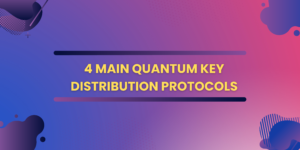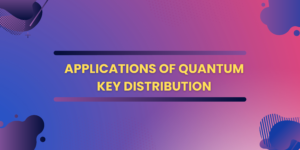Quantum Key Distribution Protocols, Quantum Key Distribution (QKD) protocols represent the cornerstone of quantum communication, offering a secure means of exchanging cryptographic keys based on the principles of quantum mechanics.
These protocols leverage the unique properties of quantum systems, such as entanglement and the uncertainty principle, to ensure the confidentiality of key distribution. In this article, we explore some notable QKD protocols, their underlying principles, and their applications in securing communication channels.

Quantum Key Distribution Protocols
- BBM92 Protocol (Bennett-Brassard 1992): The BBM92 protocol, proposed by Charles Bennett and Gilles Brassard in 1992, is one of the pioneering QKD protocols. It employs the principles of quantum entanglement and polarization-encoded photons to establish a secure key between two parties, conventionally referred to as Alice and Bob. The security of the BBM92 protocol relies on the principles of quantum mechanics, making it a foundational protocol for subsequent QKD developments.
- E91 Protocol (Ekert 1991): Proposed by Artur Ekert in 1991, the E91 protocol introduces the concept of quantum entanglement-based key distribution. In this protocol, entangled particle pairs are used to generate a secure key. The violation of Bell inequalities, a phenomenon arising from quantum entanglement, serves as a verification step to ensure the absence of eavesdropping. The E91 protocol provides a robust foundation for secure key distribution in quantum communication.
- BB84 Protocol (Bennett-Brassard 1984): The BB84 protocol, proposed by Bennett and Brassard in 1984, is another seminal QKD protocol. It relies on the polarization states of single photons to encode information. The security of BB84 is ensured by the uncertainty principle: any attempt to measure the polarization state of a photon introduces uncertainty, and any eavesdropping attempt disrupts the quantum states, revealing the presence of an intruder.
- SARG04 Protocol (Scarani et al. 2004): The SARG04 protocol, introduced by Stefano Pironio, Antonio Acín, Nicolas Brunner, Nicolas Gisin, Serge Massar, and Valerio Scarani in 2004, focuses on device-independent quantum key distribution. This approach aims to achieve security without relying on assumptions about the internal workings of quantum devices. SARG04 represents a significant step towards enhancing the robustness of QKD protocols against potential vulnerabilities.

Applications Quantum Key Distribution Protocols
- Secure Communication: The primary application of QKD protocols is to establish secure communication channels. By leveraging the unique features of quantum systems, these protocols enable the generation of cryptographic keys that remain secure against eavesdropping attempts.
- Quantum Key Management: QKD protocols form the basis for quantum key management systems. These systems encompass the secure generation, distribution, and storage of cryptographic keys, enhancing overall cybersecurity infrastructure.
- Financial Transactions: The financial sector benefits significantly from QKD protocols to secure transactions and communications between financial institutions. The ability to transmit sensitive financial data without the risk of interception is crucial for maintaining the integrity of financial systems.

Applications of Quantum Key Distribution
- Secure Communication: The primary application of QKD is in securing communication channels. By establishing a shared secret key between users, QKD ensures that the transmitted data remains confidential and immune to eavesdropping attempts.
- Quantum Key Management: Quantum key distribution provides a foundation for quantum key management systems. These systems enable the secure generation, distribution, and storage of cryptographic keys, enhancing overall cybersecurity infrastructure.
- Financial Transactions: The financial sector benefits from QKD to secure transactions and communications between institutions. The ability to transmit sensitive financial data without the risk of interception is crucial in maintaining the integrity of financial systems.
Conclusion
Quantum Key Distribution protocols stand as a testament to the marriage of quantum mechanics and information security. From the foundational BBM92 and BB84 protocols to the advancements in device-independent security with SARG04, these protocols offer a pathway to secure communication in the quantum realm. As research progresses and practical challenges are addressed, integrating QKD protocols into global communication networks holds the promise of a more secure and resilient digital future.
Also, learn
Quantum Key Distribution: Securing Communication in the Quantum Age [click here]
Quantum Computer Speed: Incredible Power of the Future [click here]

2 thoughts on “4 main Quantum Key Distribution Protocols: Safeguarding Communication in the Quantum Realm”